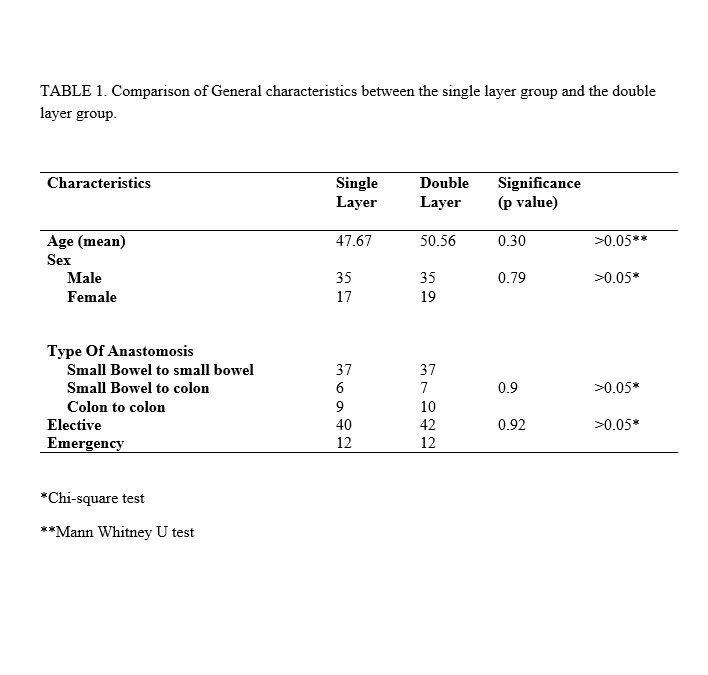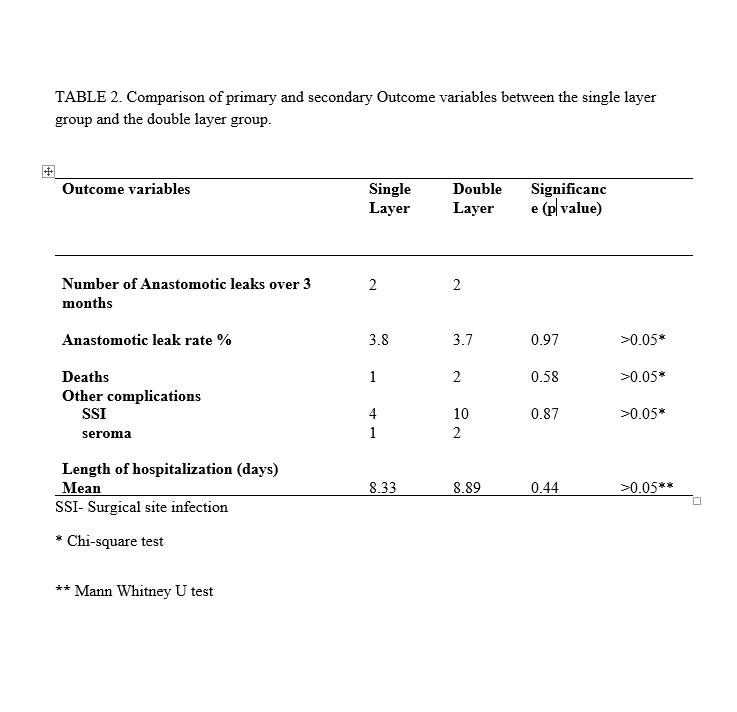EFFICACY OF SINGLE LAYERED INTESTINAL ANASTOMOSIS VERSUS DOUBLE LAYERED INTESTINAL ANASTOMOSIS- AN OPEN LABEL RANDOMIZED CONTROLLED TRIAL
Vikram Kate*2, Deivasigamani Aniruthan1, Thirugnanam Nelson1, Gubbi S. Sreenath1
1Department of Surgery, Jawaharlal Institute of Postgraduate Medical Education and Research, Pondicherry, Pondicherry, India; 2Department of General & Gastrointestinal Surgery, Jawaharlal Institute of Postgraduate Medical Education & Research (JIPMER), Pondicherry, India
INTRODUCTION:
The single layered technique and the double layered technique are the two hand sewn techniques used for intestinal anastomosis. The single layered technique is less time consuming and more cost effective than the double layer technique and appears to be equally effective and non-inferior to the double layered anastomotic technique in terms of anastomotic leak rate. Despite these advantages single layered anastomosis is not widely performed. This present study was carried out to determine that the single layer anastomotic technique is equally effective, safe, less time consuming and non-inferior to double layer anastomotic technique.
METHODS:
This study was a prospective open labeled non-inferiority randomized controlled trial conducted between October 2016 and June 2018 at a tertiary care center in South India. The study was approved by the Institute Ethics Committee (IEC). All patients above 18 years of age undergoing bowel anastomosis as elective and emergency surgical procedures were included in the study after obtaining written informed consent. Patients with gastric or rectal anastomosis were excluded. Patients were randomised into two groups. In the double layer anastomosis, the inner transmural layer was constructed in a continuous/ interrupted manner using absorbable suture and the outer Lembert sutures were taken in an interrupted manner using silk. All the single layer intestinal anastomoses were fashioned using absorbable sutures incorporating all the layers except the mucosa. The primary outcome was rate of anastomotic leak. Secondary outcomes were morbidity such as surgical site infection (SSI), mortality and length of hospitalization in the postoperative period. Patients were followed up for a period of 3 months from the day of surgery.
RESULTS:
A total of 106 patients, 52 in the single layer group and 54 in the double layer group, were included in the analysis. There was no loss of follow up during the study period. Both the groups were similar in comparison with regards to the general characteristics (Table 1). The calculated anastomotic leak rate in the single layer group is 3.8% and in the double layer group is 3.7% (p value=0.97). Mortality was comparable in both the groups. There were 5 minor complications in the single layer group and 13 in the double layer group (p value = 0.87). The mean days of length of hospitalization were 8.33 days in the single layer group and 8.89 days in the double layer group (p-value = 0.44). The differences were not statistically significant. (Table 2)
CONCLUSION:
The single layer anastomotic technique is safe, equally effective and non-inferior to double layer anastomosis in terms of morbidity and mortality.

Back to 2019 Posters




